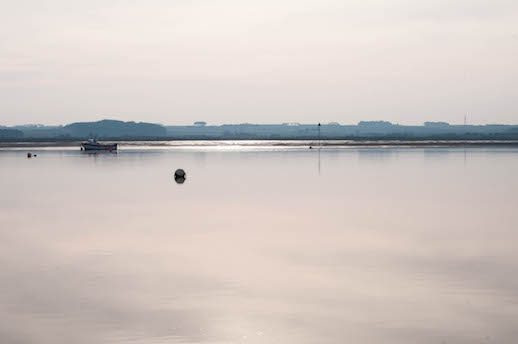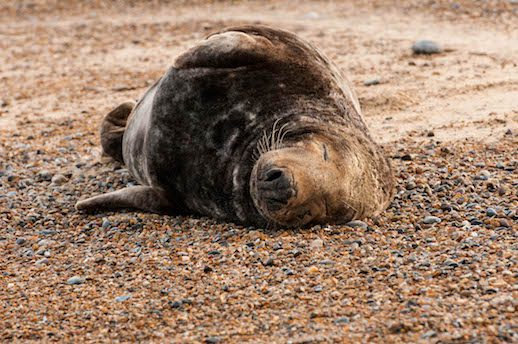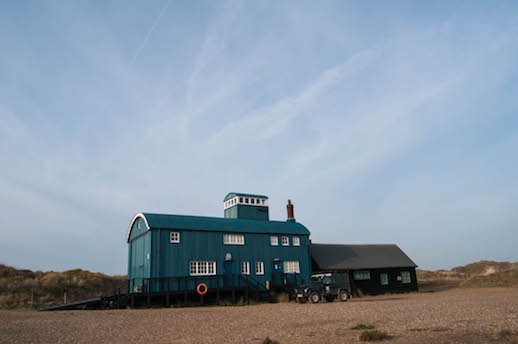Words & pictures: Danny Adcock
It is daylight when I drive into Cley beach car park and pull up against the back edge of the shingle ridge that holds back the sea in this part of North Norfolk. Scrunching up the pebbles from the landward side, the North Sea is revealed as you reach the shingle’s flattened top. There is an oily quiet across the sea’s slow, wallowing face, and each wave hauled onto the beach folds over itself, half-reluctant now it has reached the end of its passage. A collection of crab boats lie amidst some ancient-looking tractors used to pull them to and fro between sea and shingle. The weather and the tide have shovelled the pebbles into deep steps leading down to the sea. Each is strewn with locks of weed, and here and there the empty shell of a crab picked clean by greedy beaks. There is also the odd bit of rope you always find by the sea; a reminder of our need to possess and bind everything to ourselves, including the freedom of the oceans. We can’t go anywhere but we leave something behind: even in space there are countless pieces of junk and long-silent satellites orbiting endlessly, like the innumerable bits of plastic on the oceanic merry-go-round.
Walking on shingle is hard going. The pebbles give way with a grinding impermanence that sucks each footfall into a well of its own making. I go down the back of the shingle ridge again and find a more permanent footing along the edges of the salt marsh. The shingle itself, which runs West from Weybourne to my destination at Blakeney Point, is advancing toward the land at a metre a year apparently. For now, it protects the reed beds and salt marshes that hide the bitterns, marsh harriers and bearded tits that are the iconic species of North Norfolk. The reality of our long-term battle with the sea is that the Environment Agency’s plan for habitats such as these is one of ‘managed retreat’.
After a good hour-and-a-bit of walking the landscape begins to change; not spectacularly, but subtly. The salt marsh gives way to a wide bay, the shingle finishes, and an alliance of sand and marram grass as well, of course, as the sea and the weather’s unarguable force, have created huge dunes which top Blakeney Point itself. Across the beach on the seaward side lie the prostrate forms of several hundred grey seals. A National Trust sign and a rope barrier warn against getting any closer. Nobody has informed the seals of this fact though, and a large bull has dragged his not insignificant bulk up to the top of the ridge, where he lies like a languid black slug. He is so sound asleep, nostrils flaring like jet engine exhausts that occasionally backfire in a rip-roaring snort, he doesn’t even stir as I approach to a still respectful distance, and take some photos. Further down the beach two more bulls are squaring off in a bad-tempered confrontation of bellows and grunts and open-mouthed aggression. The females are altogether more delicate, their coats varying hues of pale blue-grey with uneven islands of darker colours scattered across their faces and flanks, and you could drown in the deep black liquid pools of their eyes. There is no denying that their pups – grey seals give birth between November and January – are impossibly cute. Their coats are a fluffy snow-white, and the longing in their eyes and their mournful calls are unbelievably endearing. Some are alone and stare plaintively, and some are with their very protective mothers who growl a warning if they think you’re getting too close. Further into the dunes more pups and adults lie across open patches of sand or are half-hidden amongst the marram clumps, and even sticking to the roped off paths you have to be careful of coming upon one unawares.
Behind the dunes, facing the village across the marsh and wide shallow bay of the harbour, is another icon of North Norfolk – Blakeney Point lifeboat house. Built in 1898, it didn’t last long as a lifeboat station; the increase in shingle made getting the lifeboat to the sea impossible, and now it houses the National Trust rangers. Its bright blue colour, curved roof and white-framed windows seem to belong amongst the dunes in the same way the seals do.
From high in the atmosphere a thin layer of cirrus cloud is scraped down the sky, lending an occasional anaemic weakness to the otherwise bright but cold sunlight. I can see Blakeney church on the hill above the harbour. The bay is dead calm, with the cold, burnished sheen of metal across its waters, and the only movement is an empty mooring buoy bobbing and weaving like a Southpaw on the ebb tide; sun, cloud and sea suffused in an out-of-focus over-exposure of the landscape.
Back over the ridge, the tide has ebbed far enough that another step is revealed. The shingle has given way to a compacted sand, making the walk back easier on the calves. There’s an unsettling visual distortion at the horizon which makes it look as though I am actually below the distant line where sea and sky meet, as if the whole North Sea is bearing down on me. I wonder how long it will be before the Environment Agency’s ‘managed retreat,’ is implemented; before the lifeboat house is left to the encroaching waters, and the delicate balance of the freshes is destroyed. The irony is that we’ve been in retreat for hundreds of years; many of the harbour villages on the coast here were once busy ports accommodating substantial vessels, and are now silted channels allowing only pleasure boats to pass. The sea and the coast have been inextricably linked with human culture since man first arose in Africa all those millions of years ago. Places like Blakeney Point hold a meaning far beyond many of man’s constructs, and if we are to lose some of them – and that’s not to say we should give in to this inevitability – we cannot allow what they are in our imaginations to be lost with them.
Danny Adcock on Caught by the River/on Twitter


